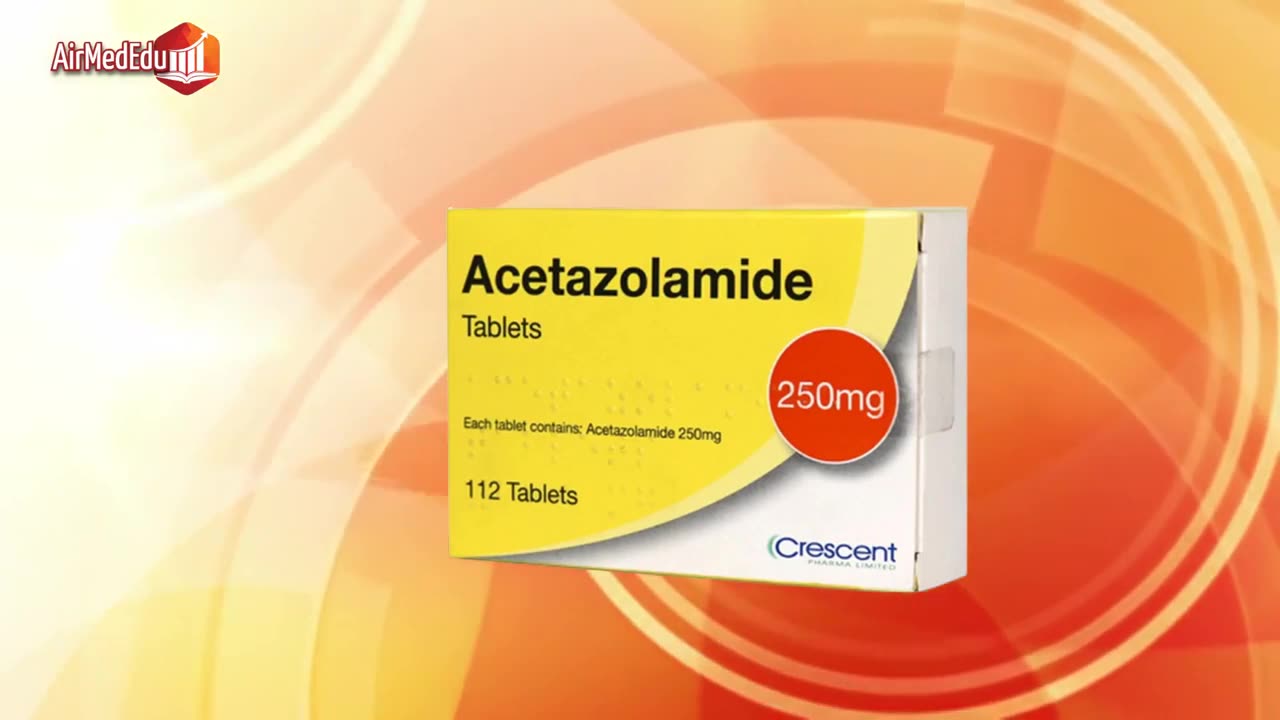Premium Only Content

Effects of Acetazolamide on the Body
Acetazolamide, commonly known by its brand name Diamox, is a drug that belongs to the class of carbonic anhydrase inhibitors. This compound works by interfering with the carbonic anhydrase enzyme, which plays a key role in regulating the body's acid-base balance and fluid production in various organs. By blocking this enzyme, acetazolamide promotes the excretion of bicarbonate in the urine, generating a mild diuretic effect and altering the pH in various tissues. Discovered in the 1950s, it has been widely used in medicine to treat conditions where excess fluid or high blood pressure is a problem. Its mechanism affects not only the kidneys but also the eyes, brain, and lungs, making it a versatile tool but one that requires careful use under medical supervision.
One of the primary therapeutic effects of acetazolamide lies in its ability to reduce intraocular pressure in patients with glaucoma. In this condition, excess fluid in the eye can damage the optic nerve and lead to vision loss. By inhibiting the production of aqueous humor in the eye, the drug lowers this pressure, offering relief in both open-angle glaucoma and acute angle-closure glaucoma, where it is used short-term before surgery. This effect is particularly valuable because it acts quickly and can prevent irreversible damage when administered promptly. Furthermore, in the context of epilepsy, acetazolamide is used as adjuvant therapy for certain types of seizures, such as absence or generalized seizures, where it helps stabilize electrical activity in the brain by modifying the ionic and acid-base balance. Although it is not a first-line antiepileptic, its complementary use has been shown to reduce the frequency of episodes in patients resistant to other treatments.
Another major benefit is its role in the prevention and treatment of altitude sickness, or acute mountain sickness. When people ascend rapidly to high altitudes, the body struggles to adapt to the reduced oxygen availability, which can cause symptoms such as headache, nausea, fatigue, and shortness of breath. Acetazolamide accelerates acclimatization by acidifying the blood, which stimulates pulmonary ventilation and increases oxygenation. Taken preventively, it reduces the severity and duration of these symptoms, allowing mountaineers and travelers to enjoy extreme altitudes with less risk. In the case of edema, especially that associated with heart failure or induced by other medications, it acts as a diuretic to eliminate excess fluids, although its potency is less than that of other diuretics such as loop diuretics. It is also used to alkalize urine in cases of poisoning by certain substances, such as methotrexate, facilitating its excretion and protecting the kidneys.
Beyond these uses, acetazolamide has found applications in conditions such as idiopathic intracranial hypertension, where it reduces cerebrospinal fluid production to relieve pressure on the brain, and in neuromuscular disorders such as periodic paralysis. In emergencies, such as intensive care, it can help manage metabolic alkalosis or stimulate respiration in patients with chronic obstructive pulmonary disease. These primary therapeutic effects highlight its versatility, but it is important to remember that its efficacy depends on proper dosage and monitoring, as the body can adapt over time, reducing its diuretic impact.
However, as with any medication, acetazolamide is not exempt from unwanted effects. These are classified into standard pharmacological categories to understand their origin and predictability. Type A adverse effects, also known as enhanced or pharmacological effects, are the most common and predictable, as they derive directly from the drug's mechanism of action and are usually dose-dependent. For example, the inhibition of carbonic anhydrase in the kidneys causes diuresis that can lead to excessive potassium loss, causing hypokalemia, manifested as muscle weakness or mild cardiac arrhythmias. Another example is metabolic acidosis, where the excretion of bicarbonate acidifies the blood, generating fatigue, nausea, or shortness of breath, especially at high doses or in patients with compromised kidney function. Paresthesias, a tingling sensation in the extremities or around the mouth, are a classic type A effect, affecting up to 20% of users and arising from alterations in ionic balance. These symptoms are usually manageable by adjusting the dose and do not pose a serious risk if monitored, but they illustrate how the therapeutic benefit can extend beyond what is desired.
In contrast, type B effects, or bizarre and idiosyncratic effects, are unpredictable and not directly related to dose, occurring in a subgroup of patients due to individual factors. Within these, allergic subtypes are prominent, as acetazolamide is a sulfonamide derivative, which can trigger immunological reactions. For example, skin rash, hives, or even severe anaphylaxis can occur in people with sulfonamide hypersensitivity, manifesting as itching, swelling, or difficulty breathing shortly after ingestion. These events, although rare, require immediate attention and contraindicate future use of the drug. Another idiosyncratic subtype involves genetic variations, such as polymorphisms in genes encoding metabolizing enzymes or receptors, which could explain why some individuals develop blood dyscrasias, such as aplastic anemia or thrombocytopenia, without an apparent cause. These reactions are not dose-dependent and highlight the importance of prior allergy testing in patients with a history of sensitivity to similar drugs.
Turning to type C effects, which are chronic or long-term, these emerge with prolonged use and can accumulate over time. One example is the formation of kidney stones, as the alkalinization of urine by acetazolamide favors the precipitation of calcium crystals, especially in extended treatments for glaucoma or epilepsy. Another chronic effect is growth retardation in children, observed with prolonged therapy, possibly due to interference with bone or electrolyte metabolism. Similar to neuroleptic-induced tardive dyskinesia, although less common with this drug, chronic use could lead to persistent disturbances in acid-base balance, causing ongoing fatigue or muscle weakness. These effects underscore the need for periodic monitoring during long-term treatment to detect early changes and adjust the regimen.
Type D, delayed or long-latency effects, manifest months or years after exposure and often involve reproductive or oncological risks. In the case of acetazolamide, there are precautions regarding teratogenic effects, as animal studies have shown fetal malformations, such as limb defects, making it not recommended during pregnancy unless the benefits outweigh the risks. Although there is no conclusive evidence of carcinogenicity in humans, its impact on cellular metabolism could theoretically increase the risk of long-term mutations, similar to other enzyme inhibitors. These effects are rare and based on limited data, but they warrant caution in vulnerable populations, such as women of childbearing age or patients with a family history of cancer.
Type E effects, related to discontinuation or withdrawal, occur when the drug is abruptly discontinued. For example, there may be a rebound phenomenon in intraocular pressure in patients with glaucoma, where discontinuation leads to a sudden increase in aqueous humor production, exacerbating symptoms. Similar to benzodiazepine withdrawal syndrome, although less intense, withdrawal can cause a rebound of acidosis or electrolyte disturbances, manifesting as nausea, fatigue, or even seizures in epileptics. To minimize this, doctors often recommend a gradual dose reduction, allowing the body to readjust without shock.
Finally, type F effects, or unexpected failures, arise from impurities or contaminants in the formulation, although they are extremely rare with regulated drugs. In hypothetical cases, such as heavy metal contamination during manufacturing, there could be additional toxicity unrelated to the active ingredient, such as liver or neurological damage. However, regulatory agencies like the FDA strictly monitor production to prevent such incidents, and there are no significant reports for acetazolamide in this regard.
In addition to intrinsic adverse effects, acetazolamide interacts with numerous medications, potentiating or attenuating their effects in ways that require monitoring. For example, when combined with high-dose aspirin, it can cause severe toxicity, including aggravated metabolic acidosis, confusion, and loss of appetite, due to competition for renal excretion. With diuretics like hydrochlorothiazide, the diuretic effect is additive, increasing the risk of dehydration or hypokalemia. Interactions with lithium reduce its excretion, elevating plasma levels and potentially causing lithium-related toxicity, such as tremors or confusion. Other drugs such as cyclosporine increase its levels, increasing the risk of nephrotoxicity, while with anticonvulsants such as phenytoin, acetazolamide can alter its metabolism, affecting seizure control. Even with supplements such as sodium bicarbonate, there is a risk of kidney stone formation. These interactions highlight the need to review the complete drug history before prescribing.
Overdose can be serious and requires immediate intervention. Toxic effects include profound metabolic acidosis, with symptoms such as severe nausea, vomiting, confusion, drowsiness, and severe electrolyte disturbances, such as extreme hyperchloremia or hypokalemia. In the central nervous system, lethargy, generalized paresthesias, or even seizures may occur, while in the kidneys, polyuria and dehydration aggravate the condition. Reported cases show that in patients with diabetes or kidney failure, intoxication can lead to coma or non-cardiogenic pulmonary edema. Treatment involves life support, electrolyte correction, and sometimes hemodialysis to remove the drug, emphasizing the importance of not exceeding prescribed doses.
Reflecting on acetazolamide, it becomes clear that, although it offers significant benefits in various conditions, its effect profile requires a balanced approach. This drug illustrates how modern pharmacology can modulate complex physiological processes, but it also highlights the risks inherent in any therapeutic intervention. It is essential that anyone considering its use consult with healthcare professionals, such as physicians or pharmacists, for a personalized evaluation that considers medical history, interactions, and appropriate monitoring. In this way, benefits are maximized while risks are minimized, ensuring responsible and informed care.
-
 6:49
6:49
The Car Guy Online
10 hours ago $1.51 earned2025–2026 Duramax FAILURES Begin! GM’s NEW Engine Nightmare? Silverado, Sierra, Yukon...
6.51K10 -
 53:56
53:56
ZeeeMedia
20 hours agoSilicon Valley, Transhumanists & the Book of Revelation ft. Jay Dyer | Daily Pulse Ep 144
8.83K11 -
 1:02:02
1:02:02
A Cigar Hustlers Podcast Every Day
1 day agoEpisode 4 Hustler Every Day Target 10/4, No More Pennies and Gronk Is The Man
3.53K1 -
 3:07
3:07
GreenMan Studio
1 day agoHOW TO NOT SELL OUT IN 2025 W/Greeman Reports
9.41K6 -
 0:43
0:43
WildCreatures
2 days ago $2.38 earnedDiver is swallowed up by a passing bait ball at Darwin Island
10.1K4 -
 1:54
1:54
Damon Imani
3 days agoDamon Left The View SPEECHLESS on Marriage And Government Overreach
13K9 -
 4:09
4:09
Memology 101
15 hours ago $0.72 earned"Journalist" REPEATEDLY tries and FAILS to bait John Fetterman into calling Trump an "AUTOCRAT"
11.4K18 -
 58:02
58:02
Dialogue works
2 days ago $5.97 earnedMatthew Hoh: Ukraine’s Army Is COLLAPSING Everywhere!
36K19 -
 17:24
17:24
Nate The Lawyer
2 days ago $2.18 earnedBREAKING: NEW Scientific Evidence Shows Men Are Better in Sports Than Women
18.4K12 -
 29:43
29:43
Code Blue Cam
2 days agoHow Missing Dipping Sauce Turned into a Felony Arrest
19K15